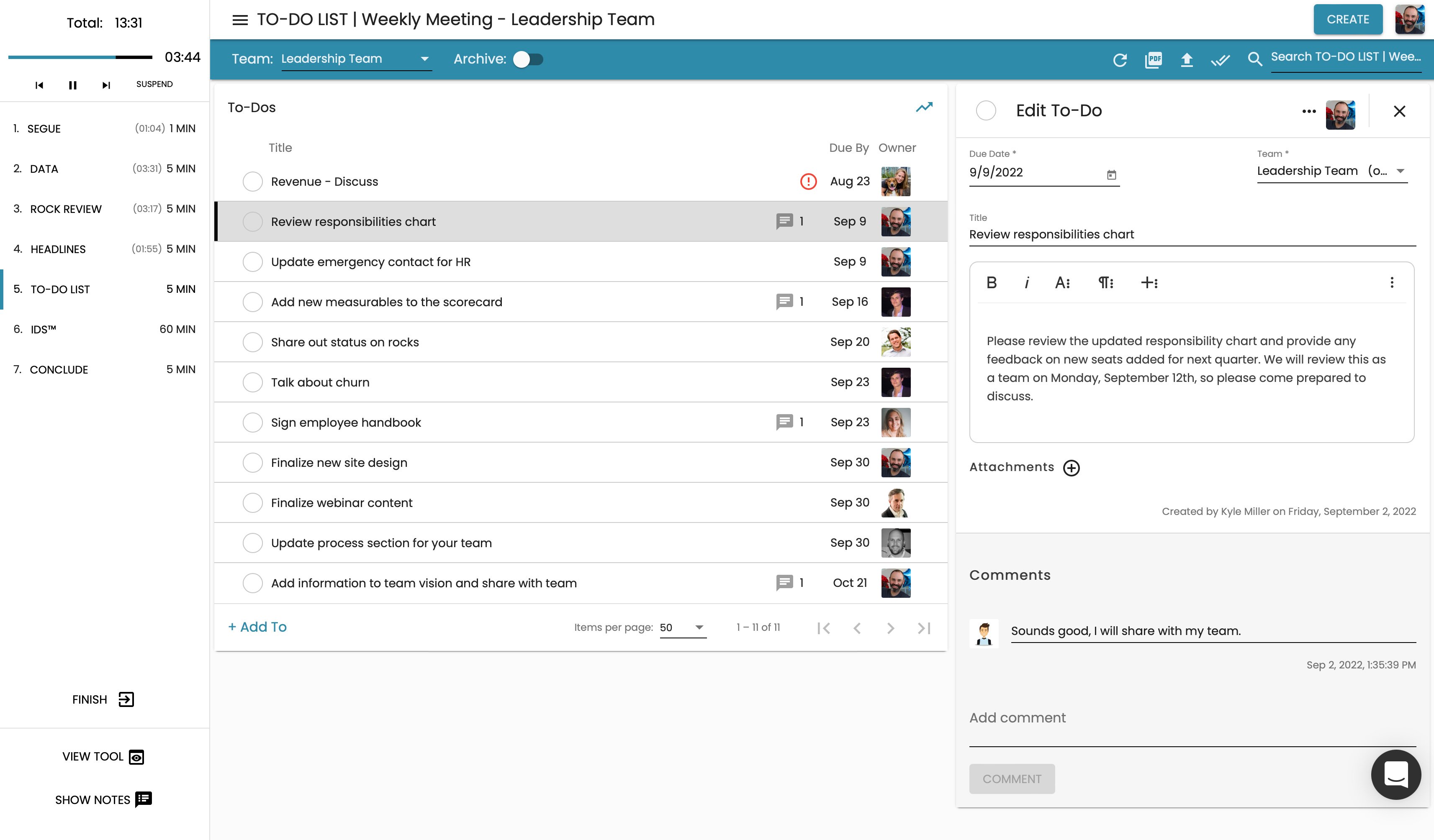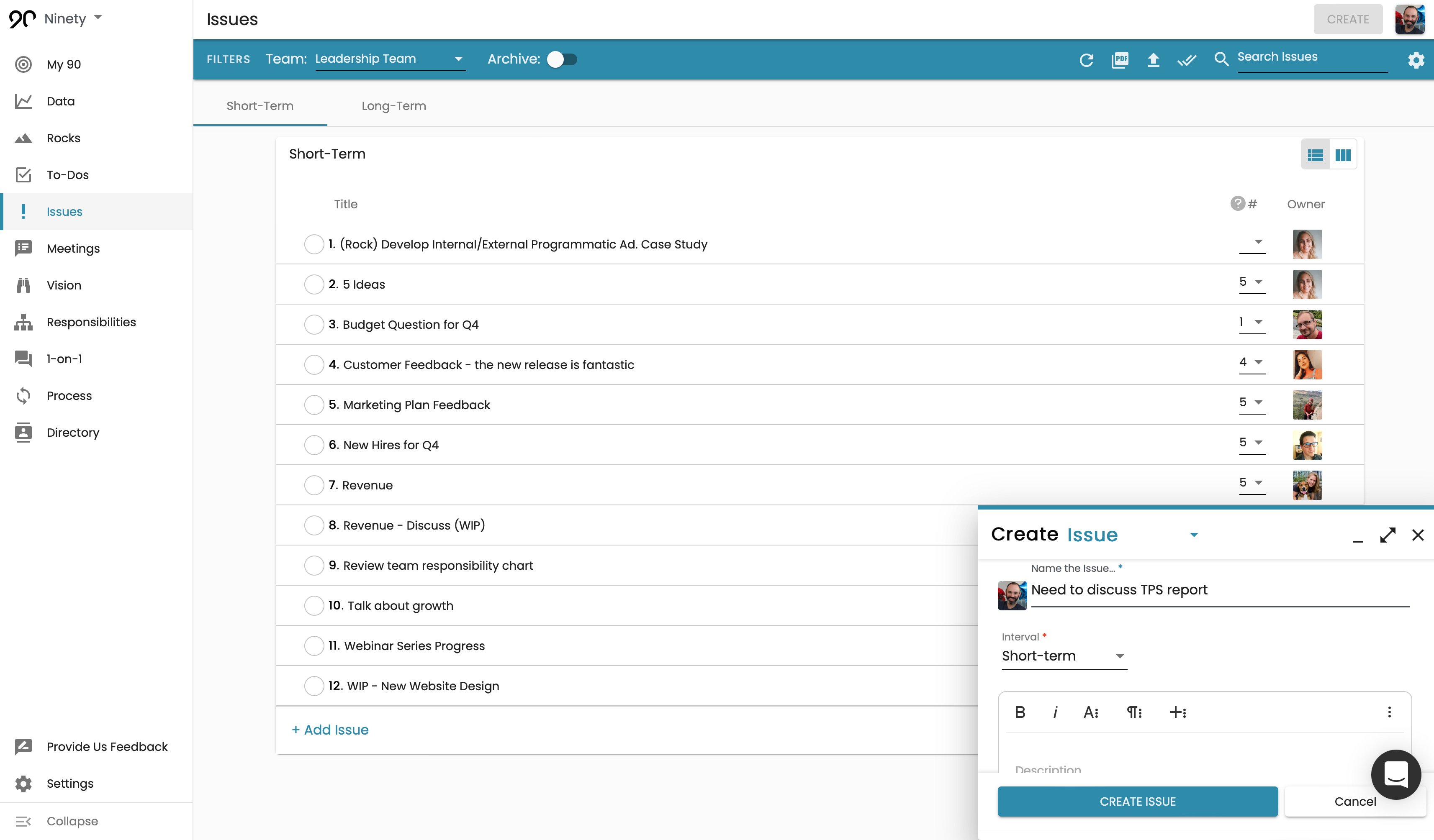
Meetings are the pulse of every team — they should bring teams together to improve trusting relationships, share progress on To-Dos and Rocks, identify items that are behind schedule, and solve current issues.
Tips for Remote, In-Person, and Hybrid Meetings
These trusted tips, paired with our software, simplify the process of getting work done.
Tip 1 — Have one facilitator and one scribe.
Meetings are most successful when we have one person leading the meeting (the facilitator) and another operating the Ninety software and documenting notes (the scribe).
Tip 2 — Screenshare Ninety when bringing remote teams together.
Have the scribe use the team’s favorite video conferencing software like Zoom, GoToMeeting, Google Hangouts, or Microsoft Teams to share their screen.
Tip 3 — Use Ninety as a visual when meeting in person.
When meeting in a conference room or meeting space with the team, display Ninety on a screen so everyone can follow the schedule together.
Tip 4 — Customize Ninety to optimize performance.
Our platform is configurable to any Business Operating System. Learn more about configurability here and how to customize the meeting agenda here.
Ninety’s Meeting Types
Each meeting category is paired with an agenda to help teams focus, align, and thrive.
Weekly Meetings
We recommend establishing a weekly meeting cadence for the Senior Leadership Team, departmental teams, and groups formed to complete a specific project.
Annual Planning Meeting
Once per year, we extend a Quarterly meeting into a two-day Annual Planning Meeting. We utilize the second day to review our Vision, revisit long-term goals, and establish new Rocks.
Foundation Session
When we bring on new clients, we start with a Foundation Session to establish the Responsibilities Chart, Data page, and more. We suggest utilizing the help of a coach or implementer for these initial sessions. Contact us for more information.
Vision Builders Session and Goals Setting Session
Within the first 90 days of using Ninety, we set aside two days to build the company’s Vision, long-term goals, Core Values, and more. We suggest utilizing the help of a coach or implementer for these initial sessions. Contact us for more information.
Quarterly Planning Meeting
We recommend holding a Quarterly Planning Meeting every 90 days. Our clients typically hold a Quarterly Planning Meeting three times yearly to review the previous quarter’s Rocks and prepare for the next. The fourth Quarterly Planning Meeting is replaced with an Annual Planning Meeting.
Customized Meetings
We’re here to help you run your business. To include a meeting type not listed above, like a daily standup or monthly check-in, create a new meeting type in Ninety. A custom meeting can include the following tools: segue, headlines, data, rocks, to-dos, issues, 90 Mastery.
How to Run the Meeting
Weekly Meetings
Establishing a Weekly Meeting cadence is critical to any team’s success. Follow these steps to maximize your experience in Ninety during the Weekly Meeting:
- Before the meeting:
-
- Add scores to relevant KPIs
- Check off any completed To-Dos
- Add headlines and Issues
- Update Rocks and Milestones
-
- Join the meeting. After the scribe starts the meeting, other team members can join via the Meetings page.
- Segue. Use the start of the Weekly Meeting to transition everyone’s focus with a casual segue. We recommend waiting to share the scribe’s screen until after the segue. Our usual segue technique has each team member share a personal and professional best from the week.
- Take notes. The scribe or any other meeting attendee can add notes directly into Ninety. These notes will be archived with the meeting and viewable at any time.
- View tools. It may be necessary to view commonly-used Ninety tools during a Weekly Meeting. Utilize the “View Tool” button on the bottom left of the screen to access the Responsibilities Chart, Vision, or other tools.
- Actively create items. Throughout the meeting, create To-Dos and Issues as needed to document work to be completed before the next meeting.
- Prioritize Issues. During the Issues section of the meeting, rank the Issues from 1 to 5, with the highest priority items marked as a 5. If there are more than three Issues, select the top three priorities to ensure they are Clarified, Discussed, and Solved (CDS).
- Rate the meeting. During the Conclusion section, team members can see a meeting summary. Then, we ask that everyone rate the meeting on a scale of 1 to 10. Before rating, the scribe can shuffle the order of the users. Attendees should start the meeting with a 10 rating in mind — if anyone rates the meeting less than a 10, they should have a reason, such as:
- The meeting started late
- The agenda wasn’t followed
- A high-priority issue wasn’t discussed or solved
- Attendees were unprepared
Quarterly Meetings
Every quarter, teams meet for a full-day Quarterly Planning Meeting (QPM) to review the previous quarter, establish the next quarter’s Rocks, and gauge their mastery of Ninety.
In addition to the above tips, here’s how to make the most of a QPM:
- Before the Meeting:
- Populate and define long-term Issues
- Update KPI data and progress on Rocks
- Review the Core Competencies
- Rank Issues as needed
- Review long-term Issues. Throughout the quarter, several Issues arise that do not pertain to the quarter’s Rocks or are not within the team’s current capacity. These long-term Issues should be discussed during Quarterly and Annual Planning Meetings. Adding detailed notes as the team identifies long-term Issues will help turn them into achievable Rocks for the next quarter.
- Complete Rocks. If a Rock was completed, mark it done. If it was not completed, move it to the long-term Issues list to be discussed at the appropriate time.


Annual Meetings
Adapting one QPM into a two-day Annual Planning Meeting allows teams the time to zoom out and assess their long-term goals and strategy. Typically, the first day is spent reviewing the previous year and participating in team health exercises. The second day focuses on the team’s Vision, 1-year goals, Rock setting, and Issues solving.
Here are some tips for a successful APM:
- Before the Meeting:
- Review the Core Competencies
- Reflect on the ups and downs of the year
- Examine the current SWOT analysis
- Update all Rocks, Issues, and KPIs
- Leave the Office. Leaving our everyday workspaces to take the time to work on the business is critical for intentional long-term planning.
- Learn from the past. Unresolved Issues, incomplete Rocks, and slumping KPIs are all opportunities to learn from. Some 90-day stretches are quarters we have won, and some are quarters we learn from.
- Gaze into the future. The APM is a unique chance to set aside daily responsibilities to consider and plan the team’s long-term aspirations.
Quick Links
A couple more things you wouldn't want to miss.
Customize any Meeting Agenda
Rearrange sections, hide areas, or insert new ones in any meeting agenda.
Send Cascading Messages
Send messages to other teams' weekly meetings to keep everyone informed!
Quarterly & Annual Reviews
Each quarter, a manager and employee connect for a 1-on-1 review.
LIVE HELP
Real people, real-time response.
7 days a week.
Office Hours
Monday – Thursday: 24 hours
Friday: Until 8 p.m. ET
Saturday: 8 a.m. to 5 p.m. ET
Sunday: 3 p.m. to midnight ET
Languages
Our support team speaks English, Spanish, French, and German!

